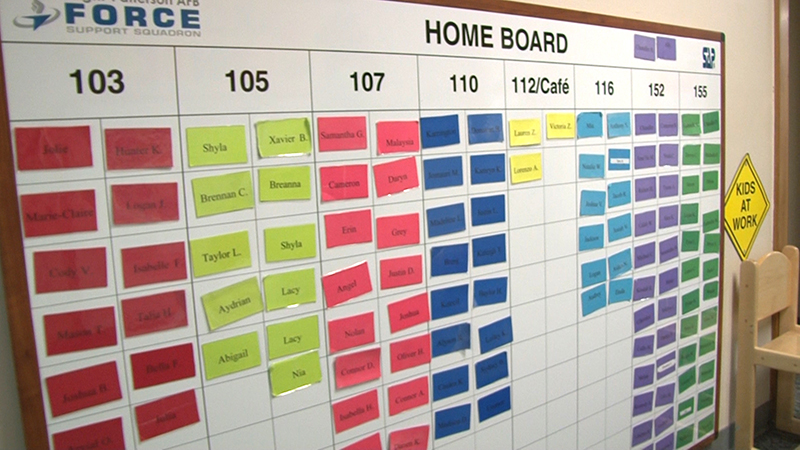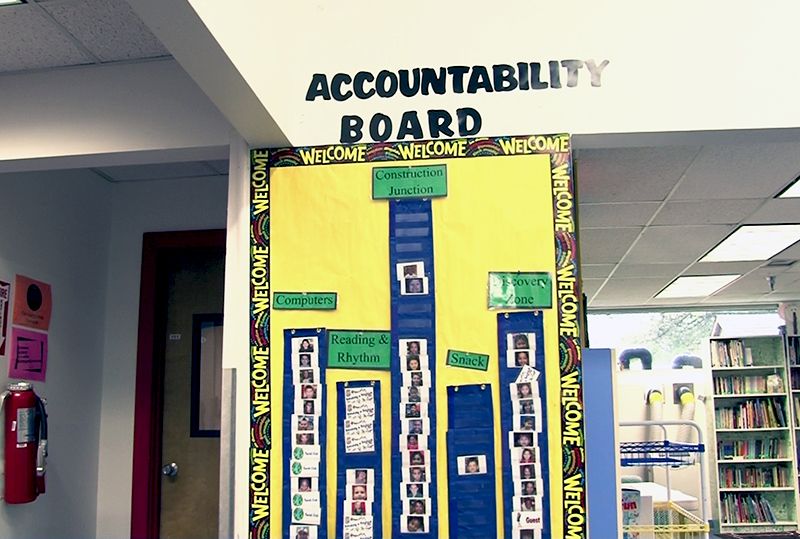- Distinguish between positive directions and negative directions.
- Develop conflict-management techniques and techniques for responding to challenging behaviors.
- Describe a collaborative process for program activities.
Learn
Know
The learning environment is not just made up of the materials and equipment, but also the activities and experiences that take place within it. As a school-age staff member, part of your role involves planning activities and experiences that support positive behavior.
Experiences to Support Positive Behavior
- Vary activities: Plan a variety of activities and experiences that reflect the current interests of the children. You can fight boredom by providing engaging activities. When children become bored, they are more likely to act out or engage in negative behaviors or peer conflicts. Keeping them motivated and interested will help promote positive behaviors.
- Meet all ability levels: When planning activities, there should be a combination of challenging, fun, and engaging activities for all ability and developmental levels in the program.
- Support social skills and teamwork: Plan activities that support cooperative play and learning as well as social skills (refer to the Social & Emotional Development course for more information on social skills.) Activities should be planned in a way that allows children to work and play together to develop their social skills.
- Celebrate differences: Plan activities and experiences that support and celebrate differences. Allow children to plan experiences that will help teach their peers about their background and traditions.
Giving school-age children autonomy over their activities will help reduce less desirable behaviors by sparking their interest and keeping them involved. According to the Council on Accreditation’s Standards for Child and Youth Development Programs, children should:
- Have opportunities to choose among program activities
- Have the option to opt out of any program activity or field trip
- Be involved in developing, planning, implementing, and evaluating activities, policies, and initiatives that reflect their needs and interests
When children are actively engaged in the planning and implementation of activities, experiences, material selection, field-trip locations and other aspects of the program, they tend to be more interested and excited, which will lead to positive behavior. You can involve them in a variety of ways; some examples are:
- Hold regular planning meetings where children can come prepared with ideas or brainstorm with their peers about what they would like to see in their learning environment. Encourage their creativity and flow of ideas as they discuss what they would like to see. Before the end of each meeting, come away with a few concrete ideas that you know you will be able to put into action. This way, children will know that you take their ideas seriously and they will be more willing to participate in the future.
Create choice boards that allow children to see what activities are available and pick where they would like to go. This also eases transitions as children can move freely from one activity to another, as long as there is space. Choice boards can be created in a variety of ways. Here are some examples:


- Develop surveys that allow children to pick from activities they would like to see in the future or give their own suggestions. Not all children will feel comfortable coming to a planning meeting, but they might have great ideas to share. You can also implement a suggestion box that lets children write down ideas for their learning environment and leave them in an anonymous box for you to look at.
Giving children the opportunity to assist with the implementation of activities will also help to increase their interest and involvement. When children are involved and interested in the program, they are more likely to be engaged and to participate in positive ways. You can involve them in a variety of ways; some examples are:
- Develop a peer tutoring or buddy program. Children may be interested in helping other children learn a skill or subject that they excel in. Match children up and allow them to help each other with their homework, reading skills, or athletic skills. This is a great way to keep children engaged in the learning process and to keep their interest.
- Invite children to teach a special skill or talent. Many children will enjoy sharing something that they love to do and can do well. Give children the opportunity to teach a craft, computer skill, musical instrument, or sport that they feel they excel in. You can let them help create extension activities for their peers to work on as well. Children will enjoy being “the teacher” and creating an activity plan. This will keep them engaged and encourage them to continue working on their special skill or talent.
- Invite children to share a special tradition or activity. Giving children the opportunity to share something unique or meaningful to them is a great way to increase their interest in the program. Encourage them to share clothing, food, holiday events, or activities that are important in their background. You can work with the child’s family to plan a special experience that reflects their traditions.
- Give children the opportunity to be a “teacher’s assistant” when you are implementing their activity idea. When children come to you with an activity or experience they want to see implemented in the program, it is always a good idea to let them help you bring it to life. Children will benefit from seeing how an idea becomes an activity plan and how that plan gets implemented into the learning environment. Let them help you make supply lists and gather materials. This will encourage them to continue thinking of ideas they would like to see and give them an idea of what kind of work it takes to make it happen.
Conflict Resolution
Disagreements and conflicts are inevitable between children from toddlerhood through adolescence, and even adulthood. The way you choose to intervene during these times of stress can directly affect how the situation unfolds. Adults may try to help school-age children resolve conflicts by playing too active of a role. Instead of letting children resolve the disagreement on their own, adults may push them to come to an agreement too quickly, perhaps because of time constraints. Though it may take more time, teaching children how to resolve conflicts on their own is an important part of positive guidance. There are two strategies we will describe here: the “five-finger formula” and group meetings.
Dan Gartrell, in Education for a Civil Society, recommends teaching children the five-finger formula for social problem solving. This method involves assigning a definition or purpose to each finger. Once children are taught this technique, they can use their own bodies to calm themselves down during times of disagreement. The five steps are listed below, and you can read more about this technique by reviewing the References & Resources provided in this Lesson.
- Cool down (thumb)
- Identify the problem (pointer)
- Brainstorm solutions (tall guy)
- Go for it (ringer)
- Follow-up (pinky)
Often, problems involve more than one child. In these instances, group meetings can be an effective strategy. You should take a more passive role and let the children facilitate the meeting. In some school-age programs, a “peace table” is used as a designated space to help provide a setting and structure for problem-solving.
A group meeting should encourage the active involvement of each child, providing a safe space and an opportunity for everyone to be heard by each other. Each child is able to share his or her thoughts, feelings, and ideas regarding a problem or solution to a problem without fear of correction by peers or adults. Guidelines for group meetings should be consistent. They can occur daily, weekly, or as needed when conflicts arise. According to Gartrell, group meetings help children identify problems and work towards solutions, and they help children build skills to help them become democratic citizens.
Some outcomes to strive for when resolving conflict:
- All parties are satisfied with the outcome. The conflict won’t actually be resolved if the children do not feel comfortable with the outcome. It is important to continue working toward a compromise and mutual feeling of satisfaction. Otherwise, conflicts will continue to come up.
- The relationship among the children involved has strengthened or improved in some way. This doesn’t mean that the children in a conflict will become close friends as soon as the conflict is resolved. Rather, it means that the children involved will have a deeper understanding of each other and will have worked together to come to a mutual agreement on the situation and will avoid conflict with each other in the future.
- The children’s ability to resolve future conflicts in a constructive way has strengthened or improved. Through the process of resolving the conflict, children should learn methods of resolving future conflicts in constructive ways. You want children to be able to resolve conflicts positively and constructively on their own. This is a major life skill that will benefit them academically, socially, and in their future careers.
Responding to Behavior That Challenges
Despite a program’s use of prevention strategies, there will still be some children who engage in challenging behavior. Similar to progressing through developmental stages, there are certain behaviors that are considered typical for specific ages as children grow. Although certain behaviors are common in school-age children, they can be challenging to adults. Behaviors, such as being overly aggressive, talking back to staff or being overly distracted, could mean something is disturbing in that child’s life and they are unable to express their feelings in an appropriate way. In most situations there is a reason for school-age children’s behaviors. You must be prepared to respond appropriately when challenging behaviors occur. Possible reasons for their behavior include health problems, learning disabilities, or trauma.
If you notice frequent challenging behavior, it is important to recognize your own role in that behavior. Frequent behavior is likely a sign that some change needs to be made. Consider the following redirection strategies:
- If children become disengaged during group time, make the group time shorter than planned and switch to a more active, child-directed activity.
- Help bored children find something interesting to do. If you notice a child is wandering around with nothing to do, offer the child suggestions (“The art area is open, Braden. Would you like to try the pottery activity?”).
- When a child engages in a challenging behavior, you must be responsive and prepared to provide the child with acceptable alternatives. It helps to include this child when planning activities.
Involving Families
All staff, regardless of age group or position, should have an understanding of how to facilitate meetings with a family whose child has challenging behavior. There are several things to keep in mind to help yourself and other staff members facilitate these meetings, according to the Center on the Social and Emotional Foundations for Early Learning:
- Begin the discussion by expressing concern for the child.
- Let the family member know that your goal is to help the child.
- Ask the family member if he or she has experienced similar situations and if he or she is concerned.
- Tell the family member that you want to work with the family to help the child develop appropriate behavior and social skills.
- Tell the family member about what is happening in the classroom or program but only after the family member understands that you are concerned about the child and are not blaming the family.
- Offer to work with the family member in the development of a behavior support plan that can be used at home and in the classroom.
- Emphasize that your focus will be to help the child develop the skills needed to be successful in the program. The child needs instruction and support.
- Stress that if you can work together, you are more likely to be successful in helping the child learn new skills.
Connect families with community agencies that provide behavior support. The Kids Included Together (KIT) program can also be a valuable resource to share with families. Families can get the individualized support they need from experts in their own homes. Many behavior consultants will work with your program, as well, to make sure the child has a consistently implemented plan.
When there is reason to think that an individualized behavior support plan is necessary for a child, families should be involved from the very beginning. Families should participate in observations of the child, share their perspectives on concerns across home and the program, participate in developing a hypothesis about the child’s behavior, contribute strategies to the plan, and be involved in implementing and evaluating the plan. The National Center for Pyramid Model Innovations (NCPMI) provides numerous resources to help you involve families in every step of the behavior-support planning process.
See
Guidance: Activities and Experiences
Guidance: Conflict Resolution
Do
As you plan activities and experiences for your school-age program, it is important that you ensure it is a collaborative process. Your program goals are based on your knowledge of child development, but the activities, materials, and physical environment should be chosen with the help of the children in your program. By observing and talking with the children in your program, you can implement a collaborative approach.
- Observe: Listen to children and notice how they are using the materials in the environment.
- Ask: Look to children for ideas on what they would like to see happening in the program.
- Brainstorm: Ask questions such as “What do you want to learn about?” or “What do you already know about?” This will help you plan activities based on the children’s interests.
- Identify: Based on observations and conversations, identify topics of interest to the children in your program.
Explore
Facilitating conflict resolution is an important part of your role as a school-age staff member. You are not only helping to resolve conflict but teaching children methods for working out conflicts on their own. Complete the Conflict Resolution activity and share your completed work with your trainer, coach, or administrator.
Apply
The Backpack Connection Series was created by TACSEI (Technical Assistance Center on Social Emotional Intervention for Young Children, which has since merged with NCPMI) to provide a way for staff and family members to work together to help young children develop social emotional skills and to reduce challenging behavior. Use the Backpack Connection Resource activity to learn more about the series and how you can use it with the children, youth, and families you serve.
Glossary
Demonstrate
Center on the Social Emotional Foundations for Early Learning (n.d.). Talking with families about problem behavior: Do’s and dont's. http://csefel.vanderbilt.edu/modules/module3a/handout2.pdf.
Fields, M. V., Merritt, P. P., Fields, D. M., & Perry, N. (2014). Constructive guidance and discipline: Birth to age eight. Pearson Higher Ed.
Edwards, C. C., & Da Fonte, A. (2012). The 5-point plan: Fostering successful partnerships with families of students with disabilities. Teaching Exceptional Children, 44, 6-13.
Gartrell, D. (2012). Education for a civil society: How guidance teaches young children democratic life skills. National Association for the Education of Young Children.
Merrill, S. (2020, September 11). Trauma is 'written into our bodies'-but educators can help. Edutopia. https://www.edutopia.org/article/trauma-written-our-bodies-educators-can-help
National Association for the Education of Young Children (2014). Principles of effective practice: two way communication. https://www.naeyc.org/principles-effective-family-engagement
National Board for Professional Teaching Standards (2012). Early childhood generalist standards for teachers of ages 3-8 (3rd ed.).
National Center on Quality Teaching and Learning. Materials for social emotional support: (1) Giving children responsibilities, (2) following children’s lead, (3) fostering connections, (4) being aware of children’s needs, (5) creating a caring community. https://headstart.gov/school-readiness/effective-practice-guides/social-emotional-development
Ostrosky, M. M., & Meadan, H. (2010). Helping children play and learn together. YC: Young Children, 65(1), 104-110.
Ostrosky, M. M., & Sandall, S. R. (Eds.). (2013). Addressing young children’s challenging behaviors (Young Exceptional Children Monograph Series No. 15). The Division for Early Childhood of the Council for Exceptional Children.
Sanchez, D. D., Steece-Doran, D., & Jablon, J. (2013). Planning for positive guidance: powerful interactions make a difference. Teaching Young Children, 6(2), 8-10. https://www.naeyc.org/resources/pubs/tyc/dec2013/planning-for-positive-guidance
Sandall, S. & Ostrosky, M. M., (Eds.). (1999). Practical ideas for addressing challenging behaviors. Young Exceptional Children Monograph Series. Sopris West.
Santos, R. M., & Ostrosky, M. M. Understanding the impact of language differences on classroom behavior. CSEFEL What Works Briefs. https://files.eric.ed.gov/fulltext/ED481990.pdf


